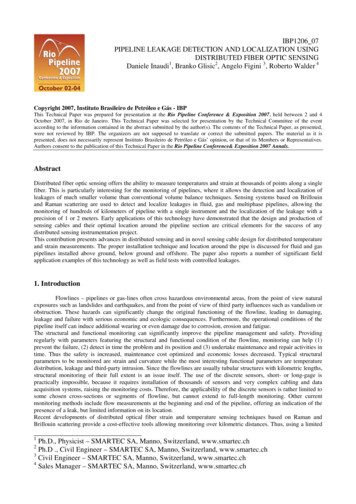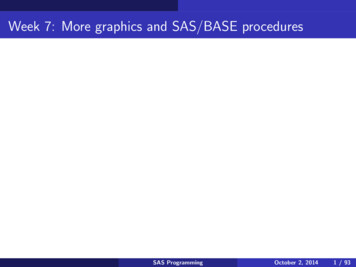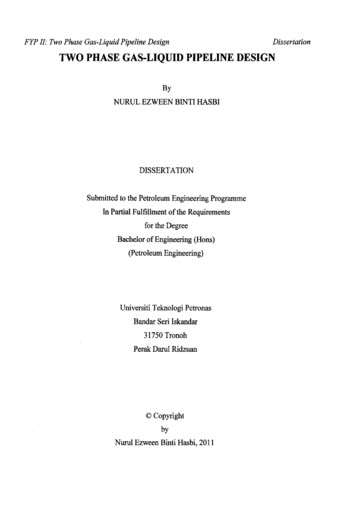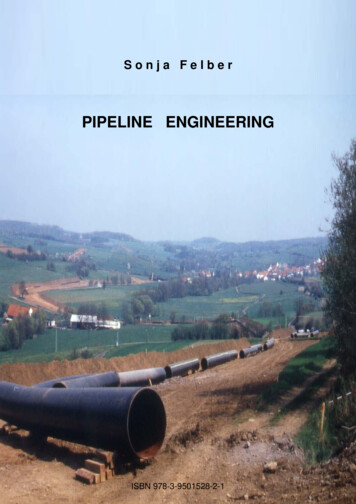
Transcription
HaGPipeProgramming the graphics pipeline in HaskellTobias Bexelius (tobias bexelius@hotmail.com)Mälardalen UniversityJune 14, 2009
AbstractIn this paper I present the domain specific language HaGPipe for graphics programming in Haskell. HaGPipe has a clean, purely functional and stronglytyped interface and targets the whole graphics pipeline including the programmableshaders of the GPU. It can be extended for use with various backends and thispaper provides two different ones. The first one generates vertex and fragmentshaders in Cg for the GPU, and the second one generates vertex shader codefor the SPUs on PlayStation 3. I will demonstrate HaGPipe’s many capabilitiesof producing optimized code, including an extensible rewrite rule framework,automatic packing of vertex data, common sub expression elimination and bothautomatic basic block level vectorization and loop vectorization through the useof structures of arrays.
Contents1 Introduction22 Haskell 10153 The pipeline114 Programs as abstract syntax trees135 General numerics186 The expression types217 Rewrite rules238 Border control279 Post pass3110 Wrapping it all up3510.1 Cg vertex and fragment shader backend . . . . . . . . . . . . . . 3610.2 SPU vertex shader backend . . . . . . . . . . . . . . . . . . . . . 3611 Results & conclusions3912 Discussion & future work4213 Related work4414 Acknowledgments451
Chapter 1Introduction3D-graphics is a computationally heavy duty; in the current state of the arta graphics pipeline model shown in figure 1.1 is used in which a stream of3D objects represented as triangles are transformed and rasterized into pixelfragments, which gets lit and merged into a 2D image1 shown on the screen.Figure 1.1: The graphics pipeline.Vertex bufferInput assemblerConstantsVerticesVertex shaderVertices with positions in canonical view spaceRasterizerConstants and texturesFragmentsFragment shaderColor and depth valuesOutput mergerFront bufferSince no global state is updated, this process is highly parallelizable, andthis is why most personal computers have a special purpose GPU (GraphicsProcessing Unit) dedicated for this task. For the last decade, the vertex andfragment shader stages has become programmable,2 providing a highly customizable graphics pipeline.All triangles sent into the pipeline are represented by three vertices where1 Thisis called the front buffer.hardware also have a programmable geometry shader stage between the vertexshader and the rasterizer that operates on whole triangles.2 Newer2
each vertex have a position in 3D and usually some additional attributes, suchas normal vectors, texture coordinates and color values. The vertex shader isa function that (in parallel) transforms each incoming vertex with attributedata into a new vertex with 3D-positions in canonical view space (i.e. wherex, y, z [ 1, 1] will be visible in the resulting frame) and possibly some alteredattribute data.The rasterizer uses the transformed positions of each triangles vertices togenerate pixel fragments for all pixels covered by the triangle in the resultingimage. The vertices attribute data outputted from the vertex shader will alsoget interpolated for all pixel fragments over the triangle.The fragment shader is then executed (in parallel) for each generated pixelfragment and computes each fragments final color and depth value. The depthvalues can be used by the output merger to filter out fragments hidden by othertriangles’ fragments.Two major APIs (Application Programming Interfaces) have evolved forthe task of managing and programming GPUs: OpenGl and DirectX. For theprogrammable shader stages, both APIs have incorporated their own shaderlanguages; OpenGl has GLSL and DirectX has HLSL. The graphics card manufacturer NVidia has also created Cg, a shading language supported by bothOpenGl and DirectX. Such shading languages are examples of domain specificlanguages, as opposed to general purpose languages such as C , Java andHaskell.When programming the graphics pipeline using one of the APIs above, thecommon workflow consists of first writing vertex and fragment shaders in one ofthe supported shader languages, and then writing a “host” program (usually inC or C ) that loads and uses those shaders as well as sets up the other nonprogrammable stages of the pipeline. In this paper I suggest another approach,and present HaGPipe3 , a DSL (Domain Specific Language) where we programthe graphics pipeline as a whole. The difference between HaGPipe and theshader languages described earlier is that HaGPipe is embedded in Haskell, afunctional language for general purpose programming with several interestingproperties. A listing of Haskell’s many features are provided in the next chapterfor those of you that haven’t had the opportunity to try this amazing languageout yet.The goal of HaGPipe for the purpose of this paper is to generate the vertexand fragment shader programs. I will provide backends for generating Cg-codeand for generating C -code for the SPUs (Synergetic Processing Units, thecoprocessors) of PlayStation 3. HaGPipe is implemented as a Haskell librarythat may be imported by a programmer in order to write shaders in Haskell. Theprogrammer won’t even need to define what backend should be used. Instead,a third part may use the shader written with HaGPipe to generate code forseveral different backends. The actual code generation will occur when we runthe Haskell program in which the backend’s generator function is applied to theHaGPipe shader. The produced code may then be compiled by a third partyshader compiler and used in a host program. If the host program is written inHaskell, there is also the opportunity to embed the HaGPipe code directly intothe host program, in order to generate and compile the shaders at the same time3 “HaGPipe” is an abbreviation of Haskell graphics pipeline, but also reminiscent to “bagpipe”, a common instrument in the hometown of GHC, the Glasgow Haskell Compiler.3
as the host program that will use them is being compiled. I’ll briefly discussthis and other possible additions to HaGPipe in chapter 12. Instead, I’ll let themain focus of this paper be the process of transforming HaGPipe into optimizedshader code.4
Chapter 2Haskell 101Haskell [16] [10] [9] has shown to be an ideal host language for EDSLs (Embedded Domain Specific Languages1 ) [6] [8] [18], and there is a wide range ofdifferent EDSLs implemented in Haskell already, even for graphics programming.2 Haskell is a deep language, and takes some time to fully understand.The purpose of this chapter is not to give a complete tutorial of the language,but rather to demonstrate the benefits of using it in the HaGPipe project, andto explain its rather uncommon syntax.Haskell is a functional language, and as such the use of functions is emphasized. The syntax for applying functions in Haskell is very concise; actuallya separating whitespace is used for function application. Instead of writingf(x,y) as is common in other languages, we simply write f x y. Another syntactic feature of Haskell is that almost every non-alphanumeric character stringmay be used as an operator, e.g. , or : . All operators in Haskell arebinary, except for the unary minus (-) operator. Any function may be usedas an operator by enclosing it in ampersands, e.g. x ‘f‘ y is equal to f x y.Dually, any operator may be used as a standard prefix function by enclosing itin parantheses, e.g. ( ) x y is equal to x y.Haskell has many interesting, and in some cases unique, features:Purity. The result of a function in Haskell is only defined on its input; giventhe same input twice, a function will always return the same output. Thismakes expressions in Haskell referentially transparent, i.e. it never matters if two identical expressions share the same memory or not. As aconsequence, the sub expression f a in the expression g (f a) (f a)only needs to be evaluated once, and the result can safely be reused forboth parameters of the function g.Immutable data. All data in Haskell is persistent, i.e. never changes oncecreated. All functions operating on data in Haskell will always return anew version of the data, leaving the old version intact. Without mutabledata, Haskell has no for- or while-loops, and recursion is the only way tocreate loops.1 Another2 Seecommon abbreviation is DSEL, Domain Specific Embedded Languages.chapter 13.5
Laziness. Since pure functions are only defined on their input, and since alldata is persistent, it doesn’t matter when an expression is evaluated. Thismakes it possible to delay the evaluation of a value until it’s needed, astrategy called lazy evaluation. This will optimize away unneeded computations, as well as make it possible to define infinite data structureswithout running out of memory.Higher order functions. In Haskell, functions are first class values and maybe passed as arguments to or returned as results from other functions. Infact, a function taking two parameters is actually a function taking oneparameter, returning a function taking another parameter, that in turnreturns the resulting value. You could partially evaluate a function inHaskell by supplying only some of the left-most arguments, a techniquecalled “currying”3 . With operators both operands may be curried, e.g.(4/) is a function taking one parameter that returns 4 divided by thatparameter, and (/4) is a function also taking one parameter but returnsthe parameter divided by 4.Closures. Creating functions in Haskell is easy: you could for instance use afunction to create another function, curry a function with one or moreparameters, or use a lambda expression. With lambda expressions, ananonymous function can be defined at the same time it’s used, whichfor instance is useful when you need to define a function to be used asargument to another function. A lambda expression can be used whereevera normal function name can be used. An example of a lambda expressionis (\ a b - abs a abs b) which is a function taking two arguments,a and b, that returns the sum of their absolute values. Common for allthese ways of creating functions is that they may contain variables from thesurrounding scope, which requires those values to be retained in memoryfor as long as the created function may be used. The retaining of a valuein a function is called a closure, and is a feature not only found in Haskell,but most languages with automatic memory management, such as C#and Java.Strong polymorphic types with type inference. All data types in Haskellare statically determined at compile time, and types can also be parameterized, like templates in C or generics in Java and .Net. Haskell incorporates type inference, which means that the type of an expression orvariable can be deduced from its context by the compiler so the programmer won’t have to explicitly write it. This is not the same as dynamictyping where expression has no type at all; in Haskell the type checkerwill generate an error if no unambiguous type could be deduced from thecontext.Data types in Haskell are declared with this syntax:data BinaryTree a Branch (BinaryTree a) (BinaryTree a) Leaf aIn this example, BinaryTree a is a parameterized type with two data constructors, Branch and Leaf, which holds different kind of member data. All3 Afterthe logician Haskell B. Curry.6
type names and their data constructors must start with an upper case character, and a data constructor can have the same name as its type. Functions onthe other hand must start with a lower case character. BinaryTree is called atype constructor, since it’s excpecting a type parameter a.A Branch has two BinaryTree’s (with the same parameter type a) and theLeaf has a single value of type a. A BinaryTree value has the form of one ofthese constructors, i.e. either it’s a branch with two sub trees, or it’s a leaf witha value. A type could have any number of constructors.4 A data constructorcould be seen as a function only that it won’t get evaluated into some othervalue. A binary operator could be used as a type or data constructor if it startswith a colon (:), such as : as we’ll see later on in this paper. The colonoperator itself is a data constructor in the Haskell list type that concatenates alist element with a trailing sub list.Some built in data types that are commonly used in Haskell are lists andtuples. Lists can contain a variable number of elements of one type and tuplescan contain a specific number of elements of different types. A list type iswritten by enclosing the element type inside square brackets (e.g. [Int]) anda tuple is written as a comma separated sequence of types enclosed by normalparantheses (e.g. (String,Int,Int)).Deconstructing a data type is done using pattern matching, as in the following example:count x (Branch y z) count x y count x zcount x (Leaf y) x y 1 otherwise 0In this example, the function count is a function taking two parametersthat counts the number of occurrences of a specific element (supplied in thefirst parameter) in a BinaryTree (provided as second argument). It has twodefinitions where the first matches the constructor Branch for the second parameter, and binds the variable x for the first parameter and the variables yand z for the Branch’s data members (the sub trees). The second definitionmatches the constructor Leaf on the second parameter instead, and also hastwo guarded paths. The first path is taken if the variables x and y are equal,otherwise the second path is taken. otherwise is actually just a constant withthe value True. Function patterns are tried in order from the top down, andthe definition of the first matching pattern with a passed guard expression willbe the result of the function application. Since Haskell is strongly typed, alldefinitions of a function must have matching types. In this case for example,the second parameter must always be a BinaryTree a.The last example also highlights another syntactic feature of Haskell, layoutrules. In Haskell, the indentation actually has a syntactic meaning and is usedinstead of a lot of curly braces ({}) to group statements together, as could beseen in other languages. This is why the second guarded line was intended tomatch the previous one. One big advantage with the layout rule is that theprogrammer is forced to write well formatted code.4 In fact, a type may even have no constructors, but in this case no values can have thistype. Such a type may only be used as a type parameter in a phantom type, explained laterin this chapter.7
Type synonyms could be declared with the type keyword as in this example:type BinaryStringTree BinaryTree StringThe type of a function is expressed with - . For example, the type of thefunction count in our example above will be inferred to a - BinaryTree a - Int,i.e. a function taking a value of type a, a BinaryTree a and returns an integer value. Actually, this is only partly true. The actual type would beEq a a - BinaryTree a - Int, saying that a must be an instance ofthe type class Eq. The keyword is used to denote a context for a type. Thetype variables (e.g. a in our previous example) can be restricted to belong tospecific type classes by stating this on the left side of . Type classes are usedin Haskell to share interface between different data types, and is similar to interfaces in Java or .Net. Type classes are actually the only way to overload afunction or operator for different data types in the same scope in Haskell. Thedeclaration of a type class looks like this:class Eq a where( ) :: a - a - Bool(/ ) :: a - a - BoolThis class has one type variable a and two operators and / that allinstances of this class must implement. The :: keyword is used to denote thetype of a function or expression in Haskell. A type class is implemented by thissyntax:instance Eq (BinaryTree a) whereBranch x y Branch z w x z && y wLeaf x Leaf y x y Falsex / y not (x y)In this example we also see the use of pattern wildcards ( ) that is matchingany expression and not bound to any variables. In an extension to standardHaskell, a type class may have more than one type variable, and could be used toexpress relations between types, something we’ll utilize frequently in HaGPipe.Subclasses can be defined by restricting what types that can be instances of aclass by using , as in the following example where Ord is a subclass of the Eqclass:class Eq a Ord a wherecompare :: a - a - Ordering( ) :: a - a - Bool( ) :: a - a - Bool( ) :: a - a - Bool( ) :: a - a - Boolmax :: a - a - amin :: a - a - a8
Given that functions in Haskell have no side effects, one might wonder howto actually perform any work in Haskell. Monads [20] are one of the moreadvanced features in Haskell that provides the means for effectful computing toHaskell. A monad is a “wrapper” type with two defined operations. These twooperations are called return and in Haskell, and is declared in a type classas:class Monad m wherereturn :: a - m a( ) :: m a - (a - m b) - m bThis class is actually not implemented on types, but on type constructors.We can see that m in the method declarations above is always used with aparameter (a or b) and thus must be a type constructor expecting one typeparameter. A monadic value is called an action, e.g. the type constructor IOimplements the Monad class so the type IO String is an IO-action that results ina String. The method return creates a simple action that wraps up a value ina monad. The resulting value from an action could be used by the operationto create a new action in the same monad. Writing monadic actions in Haskellis made easy thanks to the do-notation. By using the keyword do we couldinstead ofm a (\ x - b (\ y - c ( - d x y)))just writem dox - ay - bcd x yEvery row of a do statement is a monadic action, in our example the actionsare a, b, c and d x y. The order of evaluation is implied by the order of therows. The - keyword is used to bind the (unwrapped) result of a monadicaction to a local variable. Besides the wrapped up values, monads may alsocontain an internal state that is passed along by the operator. For examplewith the Reader monad its easy to pass along an read-only environment valuewithout the need of explicitly wire it through all functions. In the State monad,the internal state value is also writeable. With the IO monad, the internal stateis the entire world, so this monad could be used to write stateful code that forinstance accesses the file system or writes to the screen. The main functionin a Haskell program is a value of type IO (), i.e. an IO-action returning atrivial () value (i.e. nothing). Since the constructor of the IO type is private,this main function is the only way of getting a “handle” to the outside world.The definition of the Monad class ensures that the internal state of the IO monadnever may be copied or retrieved, neither can we execute IO-actions from within9
a pure function.5 As an example of how the IO monad is used, consider thissimple Haskell program:main doputStrLn "Enter your name:"name - getLineputStrLn ("Hello " name)The first row writes a prompt to the screen, the second reads input from thekeyboard, and the third writes a greeting back to the screen. Thanks to the donotation, imperative programming in Haskell is as simple as that.5 Actually, with the function unsafePerformIO this could indeed be done, but as the namesuggests, it is unsafe and only used in extremely rare cases.10
Chapter 3The pipelineWe start by defining a polymorphic data type GpuStream a, which representsa stream of as on the GPU. A stream is an abstraction of vertices, primitives,fragments, pictures etc streaming through the graphics pipeline. As mentionedbefore, for the sake of this paper we’ll limit ourselves to streams of vertices andfragments.newtype GpuStream a GpuStream ainstance Functor GpuStream wherefmap f (GpuStream a) GpuStream (f a)The data type GpuStream is polymorphic, not only to incorporate both vertices and fragments, but also the different attribute combinations they mayhave. A “vertex” or “fragment” may be any combination of types representablein a shader, e.g. floating point values or vectors. A vertex may for instancebe represented as a position vector and a normal vector. By letting GpuStreambecome an instance of the standard library Functor class, we can operate onthe vertices or fragments running through the stream. The Functor class isdefined as:class Functor f wherefmap :: (a - b) - f a - f bfmap takes a function and in our case an GpuStream, and applies the functionto all elements of the stream, resulting in a new stream. This corresponds tousing a vertex or fragment shader, but in a more modular way. It is possibleto fuse several operations together by applying fmap several times on differentfunctions. We may also use the same polymorphic functions both on generalpurpose code as well as in shaders.To transform a stream of vertices to a stream of fragments we use the functionrasterize. The declarations of this function’s type is shown below:rasterize ::ShaderRasterizable v f 11
GpuStream (VPosition, v) - GpuStream (FPosition, FFace, FWinPos, f)typetypetypetypeVPositionFPositionFFaceFWinPos V4 (Float : Vertex)V4 (Float : Fragment)Float : FragmentV2 (Float : Fragment)This function takes a stream of vertex positions paired with some data andreturns a stream of fragment positions, grouped with their facing coefficients,window positions and rasterized data.1 The type class ShaderRasterizable isused to constraint the data that can be transferred over the shader boundaries.This type class will be defined as we cover the border control in chapter 8. Wecan also see a lot of new types such as V4, V2, : , Vertex and Fragment in thedefinitions above.2 These types will also be defined in the following chapters.To generate shader code, we use the functions vertexProgram and fragmentProgramto extract information for the different shader stages:vertexProgram ::(VertexIn v, FragmentOut r) (GpuStream v - GpuStream (SMaybe r Fragment)) - Shader ()fragmentProgram ::(VertexIn v, FragmentOut r) (GpuStream v - GpuStream (SMaybe r Fragment)) - Shader ()Both of these functions take a pipeline function as argument and return aShader (). The Shader type will be explained in detail in the next chapter.A pipeline function is a transformation of a vertex stream of some input type(i.e. an instance of the VertexIn class) to a fragment stream of some outputtype (i.e. an instance of the FragmentOut class). These type classes will alsobe defined in chapter 8.1 One might expect the rasterize function to require input on how to rasterize the vertices,e.g. what kind of primitives are used and if multi sampling should be used. To keep thingssimple in this paper, we assume that these parameters are already set by the host program.2 Remember that since : starts with a colon, it could be used as a parameterized typewith two parameters, e.g. Float and Fragment.12
Chapter 4Programs as abstractsyntax treesNow that we’ve defined the pipeline wide combinators, let’s focus on what wecan do with those GpuStreams when we use the fmap function. As an examplebefore we dig into the details, let’s see how a Phong [17] shader would look likein HaGPipe:main do(writeFile "vertex.spu.cpp" . generateSPU . vertexProgram) pipeline(writeFile "fragment.cg" . generateCg . fragmentProgram) pipelinepipeline fmap fragShader . rasterize . fmap vertShadervertShader (vInPosition, vInNormal) (canonicalPos, (vertexNormal, vertexWorldPos))wheremodel uniform "modelmatrix"proj uniform "projmatrix"norm convert modelhomPos vInPosition .: V4 x y z (const 1)worldPos model * homPoscanonicalPos proj * worldPosvertexNormal norm * vInNormalvertexWorldPos convert worldPosfragShader (fragmentViewPos, , , (fragmentNormal , fragmentWorldPos)) toSMaybe (Just (fragmentColor, z fragmentViewPos))wherea 30lightPos uniform "lightpos"material uniform "material"eyePos uniform "eyepos"n normalize fragmentNormal13
lrvambientdiffusespecularfragmentColor normalize (lightPos - fragmentWorldPos)reflect (-l) nnormalize (eyePos - fragmentWorldPos)x materialpure (l * n) .* y materialiff (r * v 0) (pure ((r * v) ** a) .* z material) 0saturate(iff (l * n 0) (ambient diffuse specular) ambient)What this program does (in the main action), is that it generates source codefor a vertex shader and a fragment shader and writes it to disc. The functionpipeline in this program is our complete render pipeline. Note that we won’tactually “run” this pipeline with any data in this program, just turn it into twotext files containing source code written in some other shader languages.The functions vertShader and fragShader is mapped over the streams ofvertices and fragments respectively, and this is where all the work gets done.The . operator is used to compose functions together just as in mathematics.In vertShader we transform the position in model space to world space with amodel matrix, and then use a perspective projection matrix to get the coordinatein the canonical view space. The vertices’ normals are transformed accordinglyusing the model matrix. The rasterizer uses the canonical view coordinate tointerpolate the world position and normal over the generated fragments. ThefragShader function then use these interpolated values to calculate a Phongshaded color for each fragment. The resulting color consists of three components:ambient color, diffuse color and specular color. Ambient color is a constantcomponent, diffuse color is computed from the angle between the normal andthe incoming light, and the specular is computed from the angle between thereflected light and the viewers direction. The dot product is used to get thecosine of the angle between two vectors. We need to use some iff expressions1to make sure that fragments that aren’t facing the light doesn’t get diffuse orspecular lighting. The function pure above is used to create a vector of valuesfrom a scalar value, and .* is used for component-wise multiplication of vectors.The operator .: is called “swizzling” and is defined in the next chapter. Thenoraml arithmetic operators , - and * are extended to apply to vectors andmatrices as well, e.g. * between a matrix and a vector (as in worldPos above) isa matrix multiplication, while it’s defined as the dot product when used betweentwo vectors (as in l * n above). a ** b is defined in Haskell as “a raised tothe power of b”.We now want to take the functions vertShader and fragShader and somehow turn them into shader code, but there is no way to inspect a functionprogrammatically in Haskell. The solution is to use a special data type for theoutput of those functions that instead of containing a resulting value containsthe expression used to compute that value. This expression can then be turnedinto shader code, e.g. in Cg, and saved to file. In order to get a resulting expression from the functions we need to feed them a symbolic input value thatacts as a placeholder for the actual input that will be given to the shaders. Weneed to define this expression data type and the operators we use on it in thevertex and fragment shaders. For the expression type, we use an abstract syn1 Seechapter 5.14
tax tree (AST). An abstract syntax tree is a data structure used in compilersthat is generated by the source code parser [3]. As an example, the AST for thevariable fragmentColor in the Phong shader above would look something likefigure 4.1.Figure 4.1: AST for the fragmentColor variable.lApplyn*ConstantApply ambientApplyApplyApply0 diffusespecularambientiffsaturatefragmentColorThe AST data type is defined in HaGPipe as an algebraic data type representing a dynamically typed expression tree. The leaves are either symbolsrepresented by the Symbol data type that represents the shader input attributesand other shader variables, or constant values represented by the OrdDynamicdata type, that is a variant of the type Dynamic2 that also supports comparisonand equality. This is important because we need to be able to sort and comparedifferent ASTs in many rewrite rules. The branch nodes, created with the Applyconstructor, are applications of operators (represented by the type Op) to listsof operand ASTs:data AST Symb Symbol Constant OrdDynamic Apply Op [AST]data Symbol Variable Int TypeRep -- A common sub expressionSamplerAttribute String TypeRep -- A global sampler attributeUniformAttribute String Int -- A global uniform attributeVertexAttribute Int -- A custom vertex input attributeFragmentAttribute Int TypeRep -- A custom fragment input attributeFragmentPosition -- A fragments canonical view positionFragmentFace -- The fragments’ triangles’ normals’ z-componentFragmentWPos -- The fragments 2D window positionFragmentColor Int -- The resulting color of a fragmentFragmentDepth Int -- The resulting depth of a fragmentFragmentDiscard -- A boolean telling if the fragment is discarded2 This type can wrap any value that implements the Typeable class, i.e. types that supportstype introspection.15
Some things are worth mentioning regarding the AST. Firstly, the numberand order of arguments are dependent on the operator, e.g. the iff operator always has three arguments where the first denotes the conditional expression, thesecond contains the result if it’s true and the third if it’s false. Some operatorscan also have a variable number of operands, e.g. the operator in figure 4.1has three parameters. Secondly, all sub expressions will get aggressively inlined,e.g. ambient in figure 4.1 gets instantiated two times for the different branchesof the iff expression. In section 9, I will present a technique that eliminatessuch common sub expressions.The creation and parsing of ASTs will be split
Haskell. When programming the graphics pipeline using one of the APIs above, the common work ow consists of rst writing vertex and fragment shaders in one of the supported shader languages, and then writing a \host" program (usually in C or C ) that loads and uses those shaders as well as sets up the other non-










